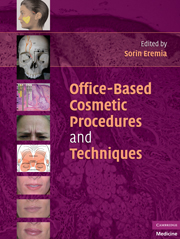Book contents
- Frontmatter
- Contents
- PREFACE
- CONTRIBUTORS
- PART ONE ANATOMY AND THE AGING PROCESS
- PART TWO ANESTHESIA AND SEDATION FOR OFFICE COSMETIC PROCEDURES
- PART THREE FILLERS AND NEUROTOXINS
- PART FOUR COSMETIC APPLICATIONS OF LIGHT, RADIOFREQUENCY, AND ULTRASOUND ENERGY
- PART FIVE OTHER PROCEDURES
- Chap. 72 SUTURE SUSPENSION LIFTS: AN OVERVIEW
- Chap. 73 SILHOUETTE SUTURES
- Chap. 74 CHEMICAL PEELS AND MICRODERMABRASION
- Chap. 75 PEELING TECHNIQUES FROM EUROPE
- Chap. 76 MESOTHERAPY: INJECTION LIPOLYSIS
- INDEX
- References
Chap. 74 - CHEMICAL PEELS AND MICRODERMABRASION
from PART FIVE - OTHER PROCEDURES
Published online by Cambridge University Press: 06 July 2010
- Frontmatter
- Contents
- PREFACE
- CONTRIBUTORS
- PART ONE ANATOMY AND THE AGING PROCESS
- PART TWO ANESTHESIA AND SEDATION FOR OFFICE COSMETIC PROCEDURES
- PART THREE FILLERS AND NEUROTOXINS
- PART FOUR COSMETIC APPLICATIONS OF LIGHT, RADIOFREQUENCY, AND ULTRASOUND ENERGY
- PART FIVE OTHER PROCEDURES
- Chap. 72 SUTURE SUSPENSION LIFTS: AN OVERVIEW
- Chap. 73 SILHOUETTE SUTURES
- Chap. 74 CHEMICAL PEELS AND MICRODERMABRASION
- Chap. 75 PEELING TECHNIQUES FROM EUROPE
- Chap. 76 MESOTHERAPY: INJECTION LIPOLYSIS
- INDEX
- References
Summary
Chemical peels are the oldest modality for skin resurfacing, having been in use for over centuries. Yet, technology continues to evolve with the introduction of newer resurfacing modalities such as dermabrasion, laser resurfacing, and, more recently, the trend toward noninvasive or so-called pixilated lasers. Interestingly, chemical peels have withstood the test of time and continue to play an important role in cosmetic dermatology. If used correctly, they can be tailored to treat almost any skin defect. Furthermore, they can be used in combination with laser resurfacing, dermabrasion, and surgical procedures to optimize the final outcome. Many physicians lack exposure and training in chemical peels in residency; however, it is an art that can be learned and can be very gratifying to both the physician and the patient.
INDICATIONS FOR CHEMICAL PEELS
The most important part of skin resurfacing is selecting the correct modality to address the patient's concerns. The physician must properly assess the patient to determine what needs to be addressed and the depth of peeling that will be needed to correct this. This is achieved by understanding skin anatomy, the depth of the cutaneous pathology being addressed, and the mechanisms of action of the various peeling agents.
As the largest organ, the skin has an important role as a barrier to environmental insults such as ultraviolet radiation, tobacco, temperature extremes, and pollution. Furthermore, there are internal influences on the skin such as hormones, inflammatory skin diseases, and systemic diseases.
- Type
- Chapter
- Information
- Office-Based Cosmetic Procedures and Techniques , pp. 333 - 344Publisher: Cambridge University PressPrint publication year: 2010
References
- 1
- Cited by



